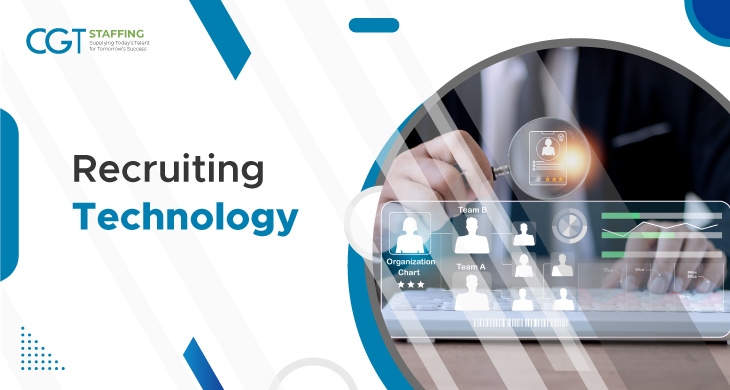In the ever-evolving landscape of talent acquisition, companies, often with the help of staffing agencies, are turning to cutting-edge technologies to gain a competitive edge. One such tool that has emerged as a game-changer is data analytics. By leveraging data analytics, organizations can optimize their recruiting technology strategies, ensuring they identify and attract the right talent efficiently.
Table of Contents
The Power of Data: A Paradigm Shift in Recruiting
Gone are the days of relying solely on gut feelings and intuition in the hiring process. In the digital age, data has become the cornerstone of effective decision-making. Recruiting technologies, when infused with data analytics, transform an organization’s talent acquisition strategy into a data-driven endeavor.
Targeted Talent Acquisition: Precision in Recruitment
In the competitive job market, identifying the right talent swiftly is paramount. Data analytics empowers recruiters to analyze vast pools of candidate information, allowing them to pinpoint individuals whose skills align perfectly with the organization’s needs. This targeted approach minimizes the time and resources spent on sifting through irrelevant applications.
Predictive Analytics: Forecasting Success
Predictive analytics takes recruitment to a new level by forecasting candidate success. By analyzing past hiring patterns and correlating them with employee performance, organizations can develop models to predict the potential success of future hires. This enables recruiters to make informed decisions, reducing the risk of a mismatch between a candidate and a role.
Transitioning from reactive to proactive hiring practices, organizations using predictive analytics gain a competitive advantage. They can identify high-potential candidates and nurture relationships with them before the need for a position arises, ensuring a steady pipeline of top talent.
Streamlining the Recruitment Funnel: Efficiency Redefined
Efficiency is the linchpin of successful recruitment. Data analytics streamlines the recruitment funnel by automating routine tasks, allowing recruiters to focus on strategic decision-making. From résumé screening to scheduling interviews, automation reduces the time and effort invested in repetitive processes. Moreover, through data evaluation a recruiting specialist can effectively determine which methods yield better results, for example the use of centralized vs decentralized recruitment methods, the advantages and disadvantages of outsourcing recruiting, or the effectiveness of different talent evaluation techniques.
Transitioning from manual to automated processes not only accelerates the recruitment timeline, it also minimizes the chances of human error. Recruiters can redirect their energy towards building relationships with candidates and stakeholders, fostering a more human-centric approach in an increasingly tech-driven industry.
Enhancing Candidate Experience: A Personal Touch
In the era of digital recruitment, providing an exceptional candidate experience is non-negotiable. Data analytics enables organizations to personalize the hiring process, creating a seamless and engaging experience for candidates.
Transitioning from a one-size-fits-all approach, personalized recruitment strategies take into account the preferences and expectations of individual candidates.
Continuous Improvement: Learning from Data Insights
The beauty of data analytics lies in its ability to provide continuous insights. Organizations can monitor and evaluate the effectiveness of their recruiting technology strategies in real time. By identifying what works and what doesn’t, recruiters can adapt and refine their approaches, ensuring a continuous cycle of improvement. They can also identify factors that point towards problem employees and reduce the chances of insubordination in the workplace.
Transitioning from static strategies to dynamic, adaptable processes is essential in the fast-paced world of recruitment. Embracing a culture of continuous improvement allows organizations to stay ahead of the curve, adjusting their strategies to meet evolving market demands and candidate expectations.
Conclusion: A Data-Driven Future of Recruitment
As we navigate the future of work, it’s evident that data analytics is not just a tool but a guiding force shaping the recruiting technologies landscape. By embracing targeted talent acquisition, predictive analytics, personalized candidate experiences, streamlined processes, diversity initiatives, and a commitment to continuous improvement, organizations can unlock the full potential of their recruiting technology strategies.
In this data-driven future of recruitment, success lies in the hands of those who not only collect data but also translate it into actionable insights. It’s a transformative journey that organizations embark on, transitioning from traditional recruitment practices to a dynamic, future-ready approach that ensures they not only find the right talent but also nurture and retain it for long-term success. If you are currently looking for a staffing firm that utilizes a data-driven approach to find suitable candidates, don’t hesitate to contact our staffing agency in Pittsburgh to learn more.
——————————————————————
FAQs
What is the most common tool used in recruiting?
The ubiquitous tool in recruiting is the Applicant Tracking System (ATS). This software streamlines the hiring process by managing applications, tracking candidate progress, and facilitating communication. Its efficiency in organizing and analyzing candidate data makes it an indispensable asset for modern recruitment, enhancing workflow, and ensuring optimal talent acquisition.
What tools do recruiters use to find candidates?
Recruiters employ various tools to find candidates, such as LinkedIn, Indeed, and specialized applicant tracking systems and recruiting engines. These platforms streamline the hiring process, enhancing efficiency and candidate reach.
What are the pros and cons of recruitment technologies?
Pros of recruitment technologies include streamlined processes, increased efficiency, and wider candidate reach. However, challenges arise with potential bias in algorithms, depersonalization of the hiring process, and the need for constant updates to keep pace with evolving technology. Balancing automation with human oversight is crucial for optimal outcomes.
